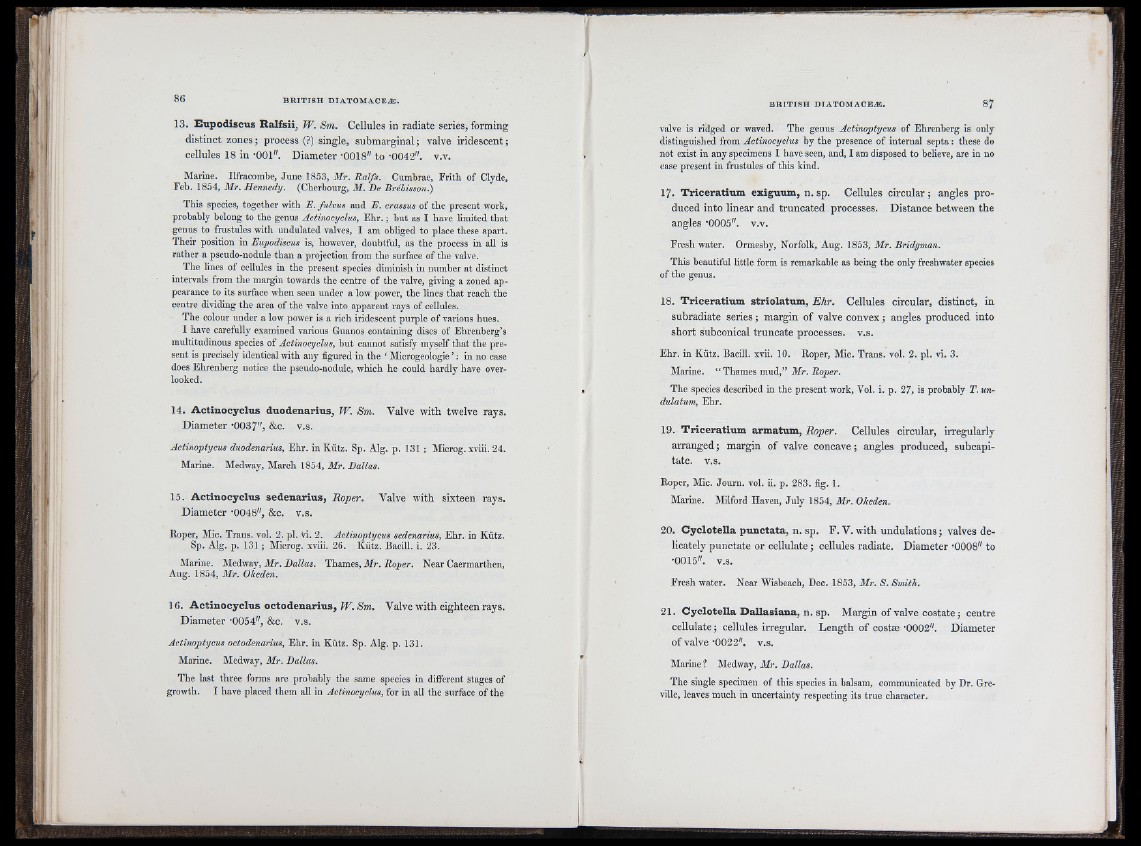
13. Eupodiscus Ralfsii, W. Sm. Cellules in radiate series, forming
distinct zones; process (?) single, submarginal; valve iridescent;
cellules 18 in -OOl". Diameter -0018" to -0042". v.v.
Marine. Ilfracombe, June 1853, Mr. Jtalfs. Cumbrae, Frith of Clyde,
Feb. 1854, Mr. Hennedy. (Cherbourg, M. Be Brébisson.)
This species, together with E. fulvus and E. crassus of the present work,
probably belong to the genus Actinoeyclus, Ehr. ; but as I have limited that
genus to frustules with undulated valves, I am obliged to place these apart.
Their position in Eupodiscus is, however, doubtful, as the process in all is
rather a pseudo-nodule than a projection from the surface of the valve.
The lines of cellules in the present species diminish in number at distinct
intervals from the margin towards the centre of the valve, giving a zoned appearance
to its surface when seen under a low power, the lines that reach the
centre dividing the area of the valve into apparent rays of cellules.
The colour under a low power is a rich iridescent purple of various hues.
I have carefully examined various Guanos containing discs of Ehrenberg’s
multitudinous species of Actinoeyclus, but cannot satisfy myself that the present
is precisely identical with any figured in the ‘ Microgeologie ’ ; in no case
does Ehrenberg notice the pseudo-nodule, which he could hardly have overlooked.
14. Actinoeyclus dnodenarius, W. Sm. Valve with twelve rays.
Diameter -0037", &c. v.s.
Actinoptycus duodenarius, Ehr. in Kütz. Sp. Alg. p. 131 ; Microg. xviii. 24.
Marine. Medway, March 1854, Mr. Balias.
15. Actinoeyclus sedenarius, Roper. Valve with sixteen rays.
Diameter -0048", &c. v.s.
Roper, Mic. Trans, vol. 2. pl. vi. 2. Actinoptycus sedenarius, Ehr. in Kûtz.
Sp. Alg. p. 131 ; Microg. xviii. 26. Kütz. Bacill. i. 23.
Marine. MeAway, Mr. Balias. Thames, Mr. Roper. Near Caermarthen,
Aug. 1854, Mr. Okeden.
] 6. Actinoeyclus octodenarius, TF. Sm. Valve with eighteen rays.
Diameter -0054", &c. v.s.
Actinoptyeus octodenarius, Ehr. in Kütz. Sp. Alg. p. 131.
Marine. Medway, Mr. Balias.
The last three forms are probably the same species in different stages of
growth. I have placed them all in Actinoeyclus, for in all the surface of the
valve is ridged or waved. The genus Actinoptycus of Ehrenberg is only
distinguished from Actinoeyclus by the presence of internal septa : tliese do
not exist in any specimens I have seen, and, I am disposed to believe, are in no
case present in frustules of this kind.
17. T r i c e r a t iu m e x ig u um , n. sp. Cellules circular; angles produced
into linear and truncated processes. Distance between the
angles ’OOOS". v.v.
Fresh water. Ormesby, Norfolk, Aug. 1853, Mr. Bridgman.
This beautiful little form is remarkable as being the only freshwater species
of the genus.
18. Triceratium striolatum, Ehr. Cellules circular, distinct, in
subradiate series ; margin of valve convex ; angles produced into
short subconical truncate processes, v.s.
Ehr. in Kütz. Bacill. xvii. 10. Roper, Mic. Trans, vol. 2. pl. vi. 3.
Marine. “ Thames mud,” Mr. Roper.
The species described in the present work. Vol. i. p. 27, is probably T. undulatum,
Ehr.
19. Triceratium armatum, Roper. Cellules circular, irregularly
aiTanged ; margin of valve concave ; angles produced, subcapi-
tate. v.s.
Roper, Mic. Journ. vol. ii. p. 283. fig. 1.
Marine. Milford Haven, July 1854, Mr. Okeden.
20. Cyclotella punctata, n. sp. F. V. with undulations ; valves delicately
punctate or cellulate ; cellules radiate. Diameter '0008" to
•0015". v.s.
Fresh water. Near Wisbeach, Dec. 1853, Mr. S. Smith.
21. Cyclotella Dallasiana, n. sp. Margin of valve costate ; centre
cellulate ; cellules irregular. Length of costæ -0002". Diameter
of valve •0022". v.s.
Marine? Medway, Mr. Balias.
The single specimen of this species in balsam, communicated by Dr. Greville,
leaves much in uncertainty respecting its true character.